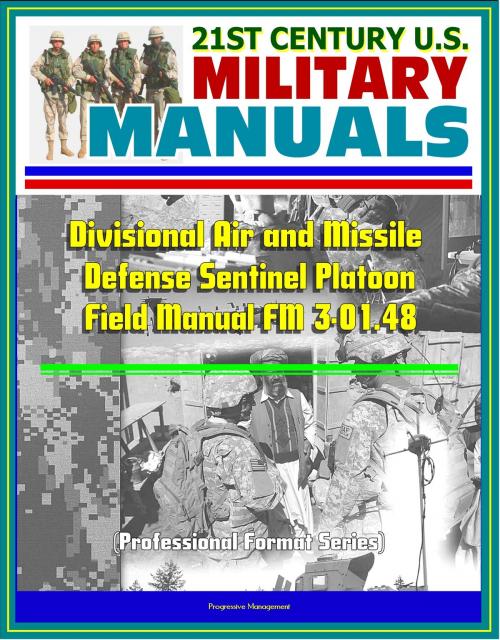21st Century U.S. Military Manuals: Divisional Air and Missile Defense Sentinel Platoon Operations Field Manual FM 3-01.48 (Professional Format Series)
Nonfiction, History, Military, United States| Author: | Progressive Management | ISBN: | 9781301478927 |
| Publisher: | Progressive Management | Publication: | November 17, 2012 |
| Imprint: | Smashwords Edition | Language: | English |
| Author: | Progressive Management |
| ISBN: | 9781301478927 |
| Publisher: | Progressive Management |
| Publication: | November 17, 2012 |
| Imprint: | Smashwords Edition |
| Language: | English |
Professionally converted for accurate flowing-text e-book format reproduction, this field manual (FM) describes the organization and employment of the digitized air and missile defense (AMD) Sentinel platoon, sections, and teams. The term Sentinel incorporates the C2 node, radar, and associated equipment. C2 and C3 are interchangeable. This FM is to be used by the AMD Sentinel platoon leader and soldiers organic to Heavy and Light Divisional AMD battalions and AMD batteries supporting those respective Heavy and Light Divisions, Light/Heavy ACRs, and Separate Brigades.
Preface * Chapter 1 * ORGANIZATION AND SYSTEM CAPABILITIES OF THE SENTINEL PLATOON. * Mission * Organization * Responsibilities * System Capabilities and Limitations * Early Warning * Force Protection * Chapter 2 * SENTINEL MANAGEMENT PLANNING, COMMAND, AND CONTROL * Management Planning * Employment Methods * Air and Missile Defense Employment Principles * Sentinel Employment Guidelines * Command and Control * Support Relationships * Military Decision-Making Process * Intelligence Preparation of the Battlefield Process * Planning Considerations * Troop-Leading Procedures * Backbriefs, Rehearsals, and Inspections * Chapter 3 * SENTINEL COVERAGE IN OFFENSIVE AND DEFENSIVE OPERATIONS * Offensive Operations * Defensive Operations * Support of Light and Special Operations * Chapter 4 * COMBAT SERVICE SUPPORT (LOGISTICS). * Functional Overview * Division Level * Brigade and Battalion Level * LOGPAC Operations * Resupply Operations * Personnel Services * Medical Evacuation Procedures * Echelons of Medical Care * Appendix A * AIR AND MISSILE DEFENSE ORDERS AND ANNEXES * Appendix B * RECONNAISSANCE, SELECTION, AND OCCUPATION OF POSITION * Methods of Reconnaissance * RSOP Sequence * Appendix C * CONTINUITY OF OPERATIONS * Sentinel * SINCGARS * Appendix D * SENTINEL MANAGEMENT CHECKLISTS * Glossary * Bibliography
As a bonus, this reproduction includes the complete 2012 Army Leadership manual (FM 6-22), which describes the Army's view of leadership, outlines the levels of leadership (direct, organizational, and strategic), and describes the attributes and core leader competencies across all levels. The principal audience for ADRP 6-22 is all leaders, military and civilian. Trainers and educators throughout the Army will also use this publication. Commanders, staffs, and subordinates ensure their decisions and actions comply with applicable United States, international, and, in some cases, host-nation laws and regulations. Commanders at all levels ensure their Soldiers operate in accordance with the law of war and the rules of engagement. It establishes and describes the leader attributes and core leader competencies that facilitate focused feedback, education, training, and development across all leadership levels. An ideal Army leader has strong intellect, physical presence, professional competence, moral character and serves as a role model. An Army leader is able and willing to act decisively, within the intent and purpose of superior leaders and in the best interest of the organization. Army leaders recognize that organizations, built on mutual trust and confidence, successfully accomplish missions.
Professionally converted for accurate flowing-text e-book format reproduction, this field manual (FM) describes the organization and employment of the digitized air and missile defense (AMD) Sentinel platoon, sections, and teams. The term Sentinel incorporates the C2 node, radar, and associated equipment. C2 and C3 are interchangeable. This FM is to be used by the AMD Sentinel platoon leader and soldiers organic to Heavy and Light Divisional AMD battalions and AMD batteries supporting those respective Heavy and Light Divisions, Light/Heavy ACRs, and Separate Brigades.
Preface * Chapter 1 * ORGANIZATION AND SYSTEM CAPABILITIES OF THE SENTINEL PLATOON. * Mission * Organization * Responsibilities * System Capabilities and Limitations * Early Warning * Force Protection * Chapter 2 * SENTINEL MANAGEMENT PLANNING, COMMAND, AND CONTROL * Management Planning * Employment Methods * Air and Missile Defense Employment Principles * Sentinel Employment Guidelines * Command and Control * Support Relationships * Military Decision-Making Process * Intelligence Preparation of the Battlefield Process * Planning Considerations * Troop-Leading Procedures * Backbriefs, Rehearsals, and Inspections * Chapter 3 * SENTINEL COVERAGE IN OFFENSIVE AND DEFENSIVE OPERATIONS * Offensive Operations * Defensive Operations * Support of Light and Special Operations * Chapter 4 * COMBAT SERVICE SUPPORT (LOGISTICS). * Functional Overview * Division Level * Brigade and Battalion Level * LOGPAC Operations * Resupply Operations * Personnel Services * Medical Evacuation Procedures * Echelons of Medical Care * Appendix A * AIR AND MISSILE DEFENSE ORDERS AND ANNEXES * Appendix B * RECONNAISSANCE, SELECTION, AND OCCUPATION OF POSITION * Methods of Reconnaissance * RSOP Sequence * Appendix C * CONTINUITY OF OPERATIONS * Sentinel * SINCGARS * Appendix D * SENTINEL MANAGEMENT CHECKLISTS * Glossary * Bibliography
As a bonus, this reproduction includes the complete 2012 Army Leadership manual (FM 6-22), which describes the Army's view of leadership, outlines the levels of leadership (direct, organizational, and strategic), and describes the attributes and core leader competencies across all levels. The principal audience for ADRP 6-22 is all leaders, military and civilian. Trainers and educators throughout the Army will also use this publication. Commanders, staffs, and subordinates ensure their decisions and actions comply with applicable United States, international, and, in some cases, host-nation laws and regulations. Commanders at all levels ensure their Soldiers operate in accordance with the law of war and the rules of engagement. It establishes and describes the leader attributes and core leader competencies that facilitate focused feedback, education, training, and development across all leadership levels. An ideal Army leader has strong intellect, physical presence, professional competence, moral character and serves as a role model. An Army leader is able and willing to act decisively, within the intent and purpose of superior leaders and in the best interest of the organization. Army leaders recognize that organizations, built on mutual trust and confidence, successfully accomplish missions.















